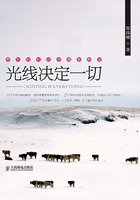
曝光过度、曝光不足与正确的曝光
在胶片时代,如何获得合适的曝光曾经是最困扰初学者的技术问题;有了数码相机即时可见的功能和数码暗房调整技术,曝光控制变得容易多了。不过,曝光与影调控制,仍然是检验影像认知水平的复杂技巧。
前面已经讲过,不同感光材料记录光线的能力都是有一定限度的。通常把感光材料在正确再现景物亮度差异前提下允许的曝光量变化的范围,称为曝光宽容度。
本页及对页下方的示例照片,展示的是对于同一场景曝光加减5级的拍摄情况。从中不难得出两个判断:曝光的偏差首先影响的是影像亮部或暗部的层次。当偏差超过一定程度时,整个画面的反差都会受到严重影响。同时,从照片上可以很明显地看出:数码相机对于曝光不足的宽容度,远远大于对曝光过度的宽容度。曝光-3EV的图像经过后期调整,仍然能得到一张可接受的照片;而+3EV的图像无论如何调整,都无法得到可接受的结果。记住这一点,对于曝光取舍时做出正确判断会很有帮助。


-5EV

-4EV

-3EV

-2EV

-1EV

0

+1EV

+2EV

+3EV

+4EV

+5EV

“准确的曝光”是一个相对的概念
从理论上讲,理想的曝光最好能涵盖画面上从最亮到最暗的全部影像层次——这种“理想情况”并非总能出现。拍摄阴天或是低反差景物时,做到这一点很容易;而拍摄光比过大的景物时,很多时候无论如何设置相机都难以做到。此时就必须进行取舍或者用人工布光来改变现场的光效。
对于同一场景,不同的拍摄者在曝光上也存在着不同的判断。以下方的示例照片来说,很可能有人觉得+1EV或是-1EV的曝光更接近他们想要的拍摄效果。同样,以右侧的照片为例:两张照片中同一辆越野车的色彩、影调相差非常大,但我们仍会认为两张照片在曝光方面都没什么问题。测光与曝光,是一个通过相机冷静估算的过程,而曝光结果的检验则往往又是非常感性化的。因此,不可能通过某条公式就一劳永逸地解决曝光的问题,仍然需要不断地实践、积累曝光控制的经验、技巧。
曝光控制技巧是本书的基本内容之一,在后面章节中,将会针对各种拍摄题材和情况加以系统的讲述。

